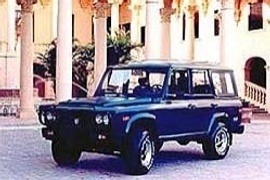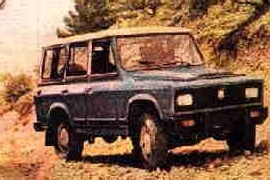ARO 24 Series Models/Series Timeline, Specifications & Photos
First production year: 1972
Engines: Diesel, Gasoline
Body style: SUV (Sports Utility Vehicle)
Once a rally winner on the Pharaohs Rally, the Romanian off-road vehicle ARO tried to survive on a fast-moving market with an outdated vehicle.
After 1989, when the Romanians overthrew the communist government, the ARO company tried to make it an independent carmaker. It was specialized in off-road vehicles. Its curved ladder-chassis and independent front suspension were modern when the car was first launched in the early 70s but outdated in the early '90s. ARO installed modern engines on the vehicle and started to sell them in foreign countries. The biggest failure was the North American market. In the U.S., ARO 24 didn't pass the roll-over safety tests performed by IIHS, and it was banned from entering the market. That was the beginning of the end for the small carmakers.
In 1991, the design department burned the midnight oil and came up with fresh ideas to develop the vehicle and improved its look. First, they changed the headlights with a pair of twin round lamps. Following the international trend, the design team moved the turn signals into the thick front bumper. The rest of the vehicle was still with flat surfaces and wedged style edges, but that style was not completely outdated.
The interior featured better materials. Apart from the regular cloth, leather upholstery was available in selected versions. Some versions were available with air-conditioning and power windows. The top of the range model, which didn't make it into production, was fitted with a 4.0-liter Ford V6 engine and a 4-speed automatic gearbox.
Apart from a few special vehicles, built by order, the rest of the range featured a choice of two turbodiesel engines. The 4x4 system featured a low-range transfer case.
Built as an offroad vehicle in former communist Romania, the Aro 24 series was a surprisingly advanced vehicle for its times.
The Romanian carmaker Aro started to build offroad vehicles in 1957 with a licensed Soviet vehicle, the GAZ 69. But the Communist Party asked the engineers to develop an original model, from front to back. Thus, the Aro 24 was born and introduced on the market in 1972. Unlike most off-road vehicles from those times, the Aro 24 featured a front independent suspension and a curved chassis, making it more comfortable on the road.
It was available in a few body versions with three or five doors or convertible. They all shared the same idea of simple, flat body panels. At the front, the carmaker installed horizontal headlights carried over from other vehicles produced in Romania to cut costs. Its front metallic front fascia featured a grille with vertical slats, like on the Gaz69. ARO installed the metallic bumper directly on the chassis's endings.
Inside, it was a simple vehicle with two seats at the front and a bench for three in the back. Depending on the version, the car featured doors in the back for the rear passengers, and all closed-body versions sported a side-hinged rear door. There was an option for side-mounted jump-seats in the trunk area, increasing the capacity of up to nine passengers.
Under the hood, the Aro24 started with a 2.5-liter gasoline engine. ARO paired it to a four-speed manual gearbox and a high and low gear transfer case for the 4x4 system. Later on, the Aro 24 received various engine versions produced by Peugeot, Toyota, Ford, or VM Motori.

